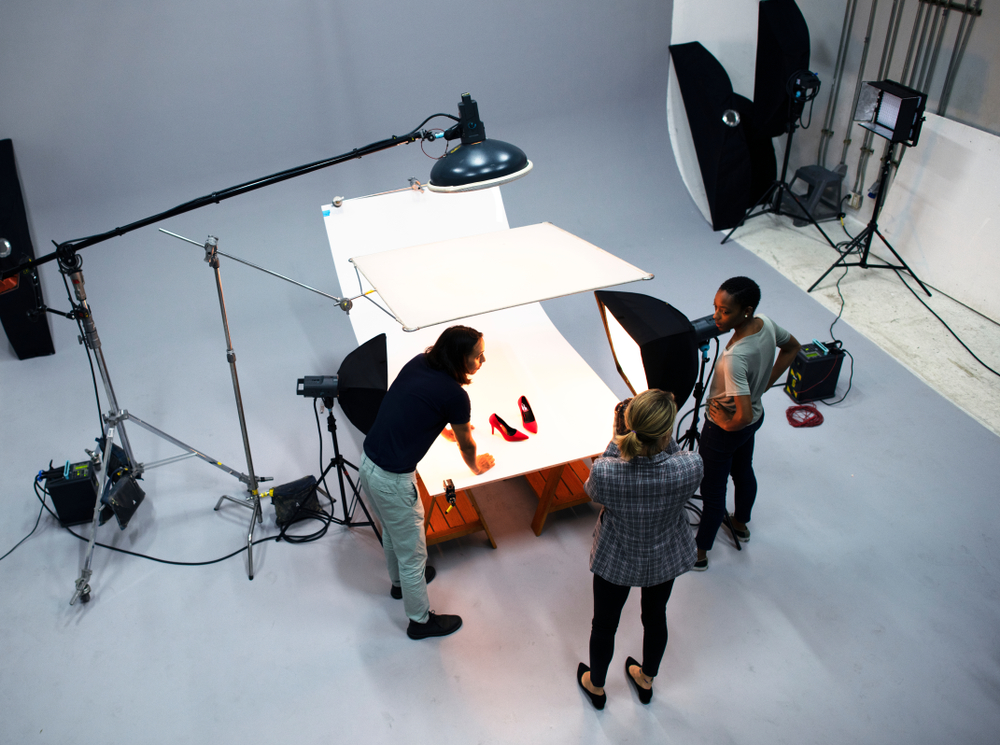In the world of advertising and marketing, high-quality visuals are paramount. Proper lighting can make all the difference, whether you’re shooting a commercial, creating content for social media, or photographing products for a catalog. Here’s a comprehensive guide on how to properly light a stationary subject for video and photo production.
Understand the Basics of Lighting
Before diving into specific techniques, it’s essential to understand the fundamentals of lighting:
- Intensity: The brightness of the light.
- Color Temperature: Measured in Kelvin (K), this describes the color of the light. Daylight with a clear sky is between 5000K-6500K, while tungsten lights are around 2500K-3500K.
- Direction: The angle at which light hits your subject affects shadows and highlights.
- Quality: Refers to how hard or soft the light is. Hard light creates sharp shadows, while soft light produces a gentle transition between light and shadow.
Use Three-Point Lighting
Three-point lighting is a standard method used in video and photo production. It involves three primary light sources:
- Key Light: The main light that shines directly on the subject, providing most of the illumination and defining the subject’s shape.
- Fill Light: A secondary light placed opposite the key light to fill in shadows created by the key light, ensuring the subject is evenly lit.
- Back Light (or Rim Light): Placed behind the subject, this light helps to separate the subject from the background, adding depth and dimension.
Choose the Right Equipment
Selecting the appropriate lighting equipment is crucial:
- LED Lights: Energy-efficient and versatile, LEDs allow you to adjust both intensity and color temperature.
- Softboxes: These diffuse light, creating a soft, even illumination that’s ideal for reducing harsh shadows.
- Reflectors: Use these to bounce light onto your subject, filling in shadows without the need for additional light sources.
- Light Stands and Clamps: Ensure your lights are securely positioned and easily adjustable.
Positioning Your Lights
Proper positioning of your lights is key to achieving the desired effect:
- Key Light: Position it at a 45-degree angle to the subject’s front and above eye level to create natural-looking shadows.
- Fill Light: Place it opposite the key light, at about the same height, but at a lower intensity to avoid creating competing shadows.
- Back Light: Set it up behind the subject, elevated, and angled towards their back. This light should be subtle but enough to outline the subject.
Control Your Environment
The environment in which you’re shooting also plays a significant role:
- Background: Choose a background that complements your subject. Keep it simple to avoid distractions.
- Ambient Light: Be aware of ambient light sources such as windows. To maintain control over your lighting setup, you might need to block or diffuse natural light.
- Color and Reflective Surfaces: Consider the colors and surfaces in your shooting area. Bright or reflective surfaces can bounce light unpredictably, affecting your setup.
Adjusting for Different Subjects
Different subjects require different lighting approaches:
- People: Soft, even lighting is generally more flattering. Use softboxes or umbrellas to diffuse the light.
- Products: Highlight the product’s features with harder light to create defined shadows and emphasize textures.
- Large Objects: Ensure even lighting across the entire object. To achieve this, you may need multiple key and fill lights.
Test and Adjust
Always test your setup before the actual shoot:
- Take Test Shots: Capture test images or footage and review them to check for unwanted shadows, hot spots, or color imbalances.
- Make Adjustments: Don’t be afraid to move lights, adjust intensity, or add diffusion materials until you achieve the desired look.
Proper lighting is an art that requires practice and experimentation. By understanding the basics, using the right equipment, and carefully positioning your lights, you can create visually stunning content that beautifully highlights your subject. Remember, the key to mastering lighting is to keep testing and adjusting until you achieve the perfect shot. Happy shooting!
Ready to take your video and photo production to the next level? Contact us today to learn more about how our expert team can help you create stunning visuals for your brand!



